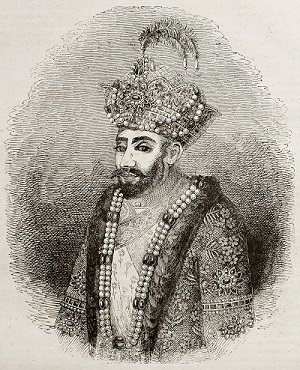

The full name of Babur is Mrz. Zahr ud-Din Muhammad. He was born on 14th February 1483 in Andijan in Uzbekistan. He was originally from Chagatai Turkic origin. He was given the honorary name Firdaws Makani. Babur was a great-great-great grandson of Timur and the oldest child of Umar Sheikh Mirza (1456–1494, governor of Fergana from 1469–1494). (1336–1405). At the age of 12, Babur confronted revolt as he succeeded to the crown of Fergana in Akhsikent.

Engraved portrait of Emperor Babur
Description: In the sixteenth century, the greatest Muslim conquerer Babur acquired Central Asia.
After Umar Sheikh Mirza passed away in 1494 after which eleven-year-old Babur took over as the emperor of Fergana, in modern-day Uzbekistan. His uncles were stubborn in their effort to throw him out of this status and many other upcoming regional holdings. Asian Daulat Begum, Babur's maternal grandmother, was a big assistance in achieving his crown, but there was also a little bit of luck involved. The city of Samarkand, which has been controlled by his paternal cousin, was the centre of conflict between opposing rulers to the west. Babur had a strong desire to take the city. He held Samarkand under siege for seven months in 1497 before finally taking it.
After killing innocents in Central Asia under the command of Najm-e Sani, the Safavid dynasty's army approached Babur for help and was offered the advice to retreat. However, the Safavids refused, and Ubaydullah Khan, a warlord, overcame them at the Battle of Ghazdewan.
Earlier connections between Babur and the Ottomans were disrupted as Sultan Selim I of the Ottoman Empire was providing advanced matchlocks and cannons which were used by his rival, Ubaydullah Khan. To aid Babur in his conquests in 1513, Selim I merged with Babur (suspecting that he might join the Safavids), sent Ustad Ali Quli, an artillery officer, and Mustafa Rumi, a matchlock sharpshooter, along with numerous other Ottoman Turks; this specific assistance would later act as the foundation for Mughal-Ottoman relations.
Babur wished to get free from the Uzbeks, so he headed to India rather than Badakhshan, which was located in the northern part of Kabul, for security. Babur initiated an attempt to capture North India after experiencing his third loss to Samarkand. He eventually reached the Chenab River, which is today in Pakistan, in 1519. His ambition up until 1524 was essential to continue on his ancestor Timur's legacy by stretching his control to Punjab. Babur headed out for Lahore in 1524 and ended up finding that Ibrahim Lodi's soldiers had driven Daulat Khan Lodi back.
Ala-ud-Din was banished by Babur in November 1525 upon receiving word from Peshawar that Daulat Khan Lodi had turned sides. Babur resumed his journey via Sirhind to Delhi. On April 20, 1526, he appeared in Panipat and confronted Ibrahim Lodi's massively outnumbered forces of about 100,000 troops and 100 elephants. Babur adopted the Tulugma technique to surround Ibrahim Lodi's army, frightening its war elephants, and force it to engage directly in artillery fire. The Lodi dynasty came to an end when Ibrahim Lodi died in the conflict. Babur mentioned this victory in his autobiography.
Ibrahim Lodi, the final Emperor of the Lodi family, was conquered and executed by Babur in 1526. Babur governed for 4 years before Humayun, who succeeded him and was conquered for a short time by the Suri dynasty. They governed for 30 years, yet religious violence lasted in India. From a Sikh-Muslim perspective, traces of brutality and trauma can be found in 16th-century Sikh literature. Babur's autobiography, Baburnama, says that his operation in northwestern parts of India focused mainly on Hindus, Sikhs, and apostates (non-Sunni sects of Islam), and a significant number of them were murdered, with Muslim camps erecting "towers of skulls of the unbelievers" on hillocks.
Zaynab Sultan Begum whom Babur wedded in 1504, died unexpectedly childless two years later. Then Babur wed Maham Begum, Masuma Sultan Begum and Gulrukh begum, and Dildar Begum. Only one of Babur's four children made it through infancy.
Although his grandson Akbar made an effort of strengthening the kingdom, Babur is regarded as the originator of the Mughal Empire.
Babur was a brilliant military explorer, a fortuitous empire builder, and a charismatic individual. Besides his career in politics, he was also a talented Turki poet who built gardens and enriched attractive locations by throwing social gatherings. He also had a passion for nature. Last but not least, his prose autobiography, the Babur-nameh, has gained notoriety. Memoirs of Babur were initially printed in two volumes in 1921–1922, having been converted from Turki into Persian during the reign of Akbar (1589).
Babur passed away in Agra on 26 December 1530.
Babur was the originator of India's Mughal rule. In his early life, he spent ten years (1494–1504) striving to seize power in Samarkand, Timur's former city. Though his activities resulted in the demise of his sovereign in Fergana (modern-day Uzbekistan), he tried to comfort himself by capturing and keeping Kabul (1504). He eventually gained control of Delhi after four unsuccessful attempts (1525). In addition to being a talented poet, Babur loved the outdoors and created gardens. His written autobiography, The Babur-nameh, has become a global standard.
Q1. What are Babur's salient characteristics?
Ans. Babur acquired the following eight essential traits: high-minded assessment, virtuous aspirations, the art of triumph, the art of administration, the art of bestowing affluence on his persons, the expertise of ruling the people of God moderately, the potential to capture the hearts of his military men, and a love of morality.
Q2. What was Babur's biggest goal?
Ans. Babur became emperor of the Farghana kingdom in Central Asia when he was 14. His ultimate goal was to govern Samarkand. He participated in several conflicts to achieve this.
Q3. Which conflict was more vital to Babur?
Ans. The Rajput alliance led by Rana Sanga of Mewar engaged the Mughal armies under Babur in the decisive Battle of Khanwa.